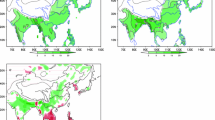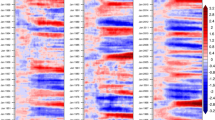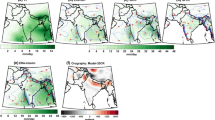Abstract
The relationship between the warm phase of El Niño southern oscillation (ENSO) and Indian summer monsoon rainfall is explored through seven coupled global climate models (CGCMs), which are semi-operational at APEC Climate Center (APCC). The 23-year (1983–2005) hindcast datasets of individual model ensembles derived from May initial conditions for southwest monsoon season (JJAS) are utilized to find out the simultaneous influence of El Niño–ISMR relationship in 1990s, which is observed to be weaker than present decades. The hindcast of ISMR climatology derived from seven individual models viz. APCC, NCEP, POAMA, SINT, SUT1, PNU and UHT1 appears to be reasonably simulated; in particular, about 50 % of mean departure is evident in most CGCMs. In addition, four of six El Niño years during the aforementioned period are well depicted in most of the CGCMs, while the years 1994 and 1997 are not represented well by these seven individual models. The warm SST anomaly aligned with surplus precipitation over tropical equatorial Pacific region simulated using APCC, NCEP, POAMA, SINT and SUT1 is relatively better than that simulated in PNU and UHT1 and it is closer to observation. The El Niño–ISMR teleconnection skills both monthly to seasonal scale are very poor in PNU as well as UHT1 and their RMSEs are 3.84 and 3.77 higher than APCC, NCEP, POAMA, SINT and SUT1 models. The authors developed two Multi-Model Ensembles (MMEs) that were simple composites of ensemble forecast from seven models (APCC, NCEP, POAMA, SINT, SUT1, PNU and UHT1) referred to as MME1, and from five models (APCC, NCEP, POAMA, SINT and SUT1) are referred to as MME2. Importantly, the one-month lead MME2 prediction of anomaly correlation coefficient (ACC) and its adverse impacts is reasonably better than MME1 prediction. However, there are some limitations in capturing SST forcing fields over Indian Ocean region in both MMEs. Among the seven models, SINT has the highest pattern correlation of precipitation over the Indian monsoon region.













Similar content being viewed by others
References
Abrol YP, Gadgil S (1999) Rice- in a variable climate. APC Publications Pvt Ltd, New Delhi, p 243
Acharya N, Kar SC, Mohanty UC, Kulkarni MA, Dash SK (2011a) Performance of GCMs for seasonal prediction over India—a case study for 2009 monsoon. Theor Appl Climatol 105(3–4):505–520. doi:10.1007/s00704-010-0396-2
Acharya N, Kar SC, Kulkarni MA, Mohanty UC (2011b) Multi-model ensemble schemes for predicting northeast monsoon rainfall over peninsular India. J Earth Syst Sci 120:795–805
Achuta Rao K, Sperber KR (2002) Simulation of the El Niño southern oscillation: results from the coupled model intercomparison project. Clim. Dyn 19:191–209
Adler RF, Huffman GJ, Chang A, Ferraro R, Xie P, Janowiak J, Rudolf B, Schneider U, Curtis S, Bolvin D, Gruber A, Susskind J, Arkin P (2003) The version 2 global precipitation climatology project (GPCP) monthly precipitation analysis (1979–present). J Hydrometeorol 4:1147–1167
Ailikun B, Yasunari T (2001) ENSO and Asian summer monsoon: persistence and transitivity in the seasonal march. J Meteorol Soc Jpn 79:145–159
Annamalai H, Slingo JM, Sperber KR, Hodges K (1999) The mean evolution and variability of the Asian summer monsoon: comparison of ECMWF and NCEP–NCAR reanalysis. Mon Weather Rev 127:1157–1186
Annamalai H, Hamilton K, Sperber KR (2007) The south Asian summer monsoon and its relationship with ENSO in the IPCC AR4 simulations. J Clim 20:1071–1092
Ashok K, Guan Z, Yamagata T (2001) Impact of the Indian Ocean dipole on the relationship between the Indian monsoon rainfall and ENSO. Geophys Res Lett 26:4499–4502
Ashok K, Chan W-L, Motoi T, Yamagata T (2004) Decadal variability of the Indian Ocean dipole. Geophys Res Lett 31:L24207
Ashok K, Sabin TP, Swapna P, Murtugudde RG (2012) Is a global warming signature emerging in the tropical Pacific. Geophys Res Lett 39:L02701
Barnett TP (1984) Prediction of the El-Nino of 1982-83. Mon Wea Rev 112:1403–1407
Barnston AG, Michael KT, Michelle LL'H, Shuhua Li, David GD (2012) Skill of real-time seasonal ENSO model predictions during 2002–11: is our capability Increasing? Bull Amer Meteor Soc 93:631–651
Behera SK, Krishnan R, Yamagata T (1999) Unusual ocean-atmospheric conditions in the tropical Indian Ocean during 1994. Geophys Res Lett 26:3001–3004
Branković Č, Palmer TN, Molteni F, Tibaldi S, Cubasch U (1990) Extended-range predictions with ECMWF models: time-lagged ensemble forecasting. Q.J.R Meteorol Soc 116:867–912. doi:10.1002/qj.49711649405
Brankovic C, Palmer TN (2000) Seasonal skill and predictability of ECMWF PROVOST ensembles. Q J R Meteorol Soc 126:2035–2067
Boschat G, Terray P, Masson S (2012) Robustness of SST teleconnections and precursory patterns associated with the Indian summer monsoon rainfall. Clim Dyn 38(11–12):2143–2165
Chakraborty A, Krishnamurti TN (2006) Improved seasonal climate forecasts of the south Asian summer monsoon using a suite of 13 coupled ocean-atmosphere models. Mon Wea Rev 134:1697–1721
Chang H-R, Webster PJ (1990) Energy accumulation and emanation at low latitudes. Part II: Nonlinear response to strong episodic forcing. J Atmos Sci 47:2624–2644
Charney JG, Shukla J (1981) Predictability of monsoons. In: Lighthill J, Pearce RP (eds) Monsoon dynamics. Cambridge University Press, Cambridge, pp 99–108
Chaudhari HS, Pokhrel S, Saha SK, Dhakate A, Yadav RK, Salunke K, Mahapatra S, Sabeerali CT, Rao SA (2012) Model biases in long coupled runs of NCEP CFS in the context of Indian summer monsoon. Int J Clim 33(5):1057–1069
DelSole T, Shukla J (2012) Climate models produce skillful predictions of Indian summer monsoon rainfall. Geophys Res Lett 39:L09703. doi:10.1029/2012GL051279
Fu X, Wang B (2004) Differences of boreal summer intraseasonal oscillations simulated in an atmosphere–ocean coupled model and an atmosphere-only model. J Clim 17:1263–1271
Gadgil S (1995) Climate change and agriculture—an Indian perspective. Curr Sci 69:649–659
Gadgil S, Sajani S (1998) Monsoon precipitation in the AMIP runs. Clim Dyn 14:659–689
Gadgil S, Vinaychandran PN, Francis PA, Gadgil S (2004) Extremes of the Indian summer monsoon rainfall, ENSO and equatorial Indian Ocean oscillation. Geophys Res Lett 31:L12213. doi:10.1029/2004GL019733
Gadgil S, Rajeevan M, Nanjundiah R (2005) Monsoon prediction: why yet another failure? Curr Sci 88:1389–1400
Gadgil S, Srinivasan J (2011) Seasonal prediction of the Indian monsoon. Curr Sci 1003:343–353
Gershunov Alexander, Schneider Niklas, Barnett Tim (2001) Low-frequency modulation of the ENSO–Indian monsoon rainfall relationship: signal or noise? J. Climate 14:2486–2492
Goswami BN, Jayavelu V (2001) On possible impact of the Indian summer monsoon on the ENSO. Geophys Res Letts 28(4):571–574
Goswami BN, Xavier PK (2005) ENSO control on the south Asian monsoon through the length of the rainy season. Geophys Res Lett 32:L18717. doi:10.1029/2005GL023216
Ham Y-G, Kang I-S (2011) Improvement of seasonal forecasts with inclusion of tropical instability waves on initial conditions. Clim Dyn 36(7–8):1277–1290
Hoskins BJ, Karoly DJ (1981) The steady linear response of a spherical atmosphere to thermal and orographic forcing. J Atmos Sci 38:1179–1196
Janakiraman S, Ved M, Laveti RN, Yadav P, Gadgil S (2011) Prediction of the Indian summer monsoon rainfall using a state-of-the-art coupled ocean-atmosphere model. Curr Sci 100(3):354–362
Jeong HI, Ashok K, Song BG, Min Y-M (2008) Experimental 6-month hindcast and forecast simulations using CCSM3, APCC 2008 Technical Report, APEC Climate Center
Jeong HI, Doo YL, Ashok K, Joong-Bae A, June-Yi L, Jing-Jia L, Jae-Kyung ES, Harry HH, Karl B, Yoo-Geun H (2012) Assessment of the APCC coupled MME suite in predicting the distinctive climate impacts of two flavors of ENSO during boreal winter. Clim Dyn 39:475–493. doi:10.1007/s00382-012-1359-3
Joseph S, Sahai AK, Goswami BN, Terray P, Masson S, Luo J-J (2012) Possible role of warm SST bias in the simulation of boreal summer monsoon in SINTEX-F2 coupled model. Clim Dyn 34:1561–1576. doi:10.1007/s00382-011-1264-1
Kanamitsu M, Ebisuzaki W, Woollen J, Yang S-K, Hnilo JJ, Fiorino M, Potter GL (2002a) NCEP–DOE AMIP-II reanalysis (R-2). Bull Am Meteorol Soc 83:1631–1643
Kanamitsu M, Kumar A, Juang HMH, Wang W, Yang F, Schemm J, Hong SY, Peng P, Chen W, Ji M (2002b) NCEP dynamical seasonal forecast system. Bull Am Meteorol Soc 83:1019–1037
Kang IS, Jin K, Wang B, Lau KM, Shukla J, Krishnamurthy V, Schubert SD, Waliser DE, Stern WF (2002) Intercomparison of the climatological variations of Asian summer monsoon precipitation simulated by 10 GCMs. Clim Dyn 19:383–395
Kar SC, Acharya N, Mohanty UC, Kulkarni MA (2011) Skill of mean of distribution of monthly rainfall over India during July using multi-model ensemble schemes. Int J Climatol. doi:10.1002/joc.2334
Kim HM, Webster PJ, Curry JA (2011) Modulation of north Pacific tropical cyclone activity by the three phases of ENSO. J Clim 24:1839–1849
Kinter JL, Miyakoda K, Yang S (2002) Recent changes in the connection from the Asian monsoon to ENSO. J Clim 15:1203–1214
Kirtman BP, Shukla J (2000) Influence of the Indian summer monsoon on ENSO. Q J R Meteorol Soc 126:1623–1646
Kripalani RH, Kulkarni A (1999) Climatology and variability of historical soviet snow depth data: some new perspectives in Snow-Indian monsoon teleconnections. Clim Dyn 15:475–489
Krishnan R, Zhang C, Sugi M (2000) Dynamics of breaks in the Indian summer monsoon. J Atmos Sci 57:1354–1372
Krishnamurthy V, Goswami BN (2000) Indian monsoon-ENSO relationship on inter decadal time scales. J Clim 13:579–595
Krishnamurti TN, Kishtawal CM, LaRow TE, Bachiochi DR, Zhang Z, Williford CE, Gadgil S, Surendran S (1999) Improved weather and seasonal climate forecasts from multi-model superensemble. Science 285:1548–1550
Kucharski F, Bracco A, Yoo JH, Molteni F (2007) Low-frequency variability of the Indian monsoon–ENSO relationship and the tropical Atlantic: the ‘weakening’ of the 1980s and 1990s. J Clim 20:4255–4266
Kucharski F, Bracco A, Yoo JH, Molteni F (2008) Atlantic forced component of the Indian monsoon interannual variability. Geophys Res Lett 35:L04706. doi:10.1029/2007GL033037
Kumar KK, Soman MK, Kumar KR (1995) Seasonal forecasting of Indian summer monsoon rainfall: a review. Weather 50:449–467
Kumar KK, Rajagopalan B, Cane MA (1999) On the weakening relationship between the Indian monsoon and ENSO. Science 284(5423):2156–2159
Kumar V, Krishnan R (2005) On the association between the Indian summer monsoon and the cyclone activity over Northwest Pacific. Curr Sci 88(4):602–612
Kumar KK, Rajagopalan B, Hoerling M, Bates G, Cane M (2006) Unraveling the mystery of Indian monsoon failure during El Niño. Science 314(5796):115–119
Kumar KK, Kamala K, Rajagopalan B, Hoerling MP, Eischeid JK, Patwardhan SK, Srinivasan G, Goswami BN, Nemanai R (2011) The once and future pulse of Indian monsoonal climate. Clim Dyn 36:2159–2170. doi:10.1007/s00382-010-0974-0
Latif M, Anderson D, Barnett T, Cane M, Kleeman R, Leetmaa A, O’Brien J, Rosati A, Schneider E (1998) A review of the predictability and prediction of ENSO. J Geophys Res 103(C7):14375–14393. doi:10.1029/97JC03413
Lau K-M, Lim H (1984) On the dynamics of equatorial forcing of climate teleconnections. J Atmos Sci 41(2):161–176
Lee J-Yi, Wang B, Kang I-S, Shukla J (2010) How are seasonal prediction skills related to models’ performance on mean state and annual cycle. Clim Dyn 35:267–283
Lorenz EN (1969) The predictability of a flow which possesses many scales of motion. Tellus 21:289– 307. doi:10.1111/j.2153-3490.1969.tb00444.x
Luo JJ, Masson S, Behera S, Shingu S, Yamagata T (2005) Seasonal climate predictability in a coupled OAGCM using a different approach for ensemble forecasts. J Clim 18:4474–4497
Min Y-M, Kryjov VN, Oh SM (2014) Assessment of APCC multimodel ensemble prediction in seasonal climate forecasting: retrospective (1983–2003) and real-time forecasts (2008–2013). J Geophys Res 119:12132–12150. doi:10.1002/2014JD022230
Mooley DA, Parthasarathy B (1984a) Fluctuation in all-India summer monsoon rainfall during 1871–1985. Clim Change 6:287–301
Mooley DA, Parthasarathy B (1984b) Indian summer monsoon and El Niño. Pure Appl Geophys 121:339–352
Mujumdar M, Kumar V, Krishnan R (2007) Indian summer monsoon drought of 2002 and its linkage with tropical convective activity over northwest Pacific. Clim Dyn 28:743–758. doi:10.1007/s00382-006-0208-7
Nitta T (1987) Convective activities in the tropical western Pacific and their impact on the northern hemisphere summer circulation. J Meteorol Soc Jpn 41:373–390
Parthasarathy B, Kumar KR, Munot AA (1991) Evidence of secular variations in Indian monsoon rainfall—circulation relationships. J Clim 4:927–938
Parthasarathy B, Munot AA, Kothawale DR (1994) All-India monthly and seasonal rainfall series: 1871–1993. Theor Appl Climatol 49:217–224
Pradhan PK, Ashok K, Preethi B, Krishnan R, Sahai AK (2011) Modoki, IOD and Western NorthPacific typhoons: possible implications for extreme events. J Geophys Res 116:D18108
Prasanna V, Annamalai H (2012) Moist dynamics of extended monsoon breaks over south Asia. J Clim 25:3810–3831
Preethi B, Kripalani RH, Krishna Kumar K (2010) Indian summer monsoon rainfall variability in global coupled ocean-atmospheric models. Clim Dyn 35:1521–1539
Rasmusson EM, Carpenter TH (1983) The relationship between eastern equatorial Pacific sea surface temperature and rainfall over India and Sri Lanka. Mon Weather Rev 111:517–528
Rajeevan M, Pai DS, Dikshit SK, Kelkar RR (2004) IMD’s new operational models for long range forecast of southwest monsoon rainfall over India and their verification for 2003. Curr Sci 86(3):422–431
Rajeevan M, Pai DS (2006) On El Niño-Indian monsoon predictive relationships. NCC Research Report 4, Indian Meteorological Department, Pune 411 005
Rajeevan M, Pai DS, Kumar RA, and Lal B (2007) New statistical models for long-range forecasting of southwest monsoon rainfall over India. Clim Dyn. doi:10.1007/s00382-006-019706
Rajeevan M, Nanjundiah RS (2009) Coupled model simulations of twentieth century climate of the Indian summer monsoon. In: Mukunda N (ed) Current trends in science-platinum jubilee special. Indian Academy of Science, pp 537–567. http://www.ias.ac.in/academy/pjubilee/book.html
Rajeevan M, Unnikrishnan CK, Preethi B (2012) Evaluation of the ENSEMBLES multi-model seasonal forecasts of Indian summer monsoon variability. Clim Dyn 38:2257–2274
Saha S, Nadiga S, Thiaw C, Wang J, Wang W, Zhang Q, Van den Dool HM, Pan HL, Moorthi S, Behringer D, Stokes D, Penã M, Lord S, White G, Ebisuzaki W, Peng P, Xie P (2006) The NCEP climate forecast system. J Clim 19:3483–3517
Saji NH, Goswami BN, Vinayachandran PN, Yamagata T (1999) A dipole mode in the tropical Indian Ocean. Nature 401:360–363
Shukla J, Kirtman BP (1996) Predictability and error growth in a coupled ocean-atmosphere model. COLA Tech Rep 24:1–13
Sikka DR (1980) Some aspects of large-scale fluctuations of summer monsoon rainfall over India in relation to fluctuations in planetary and regional scale circulation parameters. Proc Ind Acad Sci (Earth & Planetary Sciences) 89:179–195
Slingo J (1999) The Indian summer monsoon and its variability. In: Navarra A (ed) Beyond El Niño: decadal and interdecadal climate variability. Springer, Berlin, pp 103–118
Slingo JM, Annamalai H (2000) 1997: the El Nin˜o of the century and the response of the Indian summer monsoon. Mon Weather Rev 128:1778–1797
Sun J, Ahn J-B (2011) A GCM-based forecasting model for the landfall of tropical cyclones in China. Adv Atmos Sci 28:1049–1055. doi:10.1007/s00376-011-0122-8
Swaminathan MS (1987) Abnormal monsoons and economic consequences: the Indian experiment. In: Fein JS, Stephens PL (eds) Monsoons. Wiley, New York, pp 121–134
Smith TM, Reynolds RW, Peterson TC, Lawrimore J (2005) Improvements to NOAA’s historical merged land–ocean surface temperature analysis (1880–2006). J Clim 21:2283–2296
Trenberth KE (1997) The definition of El Niño. Bull Amer Meteorol Soc 78:2771–2777
Walker GT (1923) Correlation in seasonal variations of weather, VIII. A preliminary study of world weather. Mem India Meteorol Dept 4:53–84
Wang B, Kang I-S, Lee J-Y (2004) Ensemble simulations of Asian–Australian monsoon variability by 11 AGCMs. J Clim 17:803–818
Wang B, Lee J-Y et al (2009) Advance and prospect of seasonal prediction: assessment of the APCC/CliPAS 14-model ensemble retroperspective seasonal prediction (1980-2004). Clim Dyn 33:93–117. doi:10.1007/s00382-008-0460-0
Webster PJ, Houze RA Jr (1991) The equatorial mesoscale experiment, EMEX. Bull Amer Meteor Soc 72:1481–1505
Webster PJ, Lukas R (1992) TOGA-COARE: The Coupled Ocean-Atmosphere Response Experiment. Bull Amer Meteor Soc 73:1377–1416
Webster PJ, Magana VO, Palmer TN, Shukla J, Tomas RT, Yanai M, Yasunari T (1998) Monsoons: processes, predictability and the prospects of prediction. J Geophys Res 103:451–510
Wu R, Kirtman BP (2003) On the impacts of Indian summer monsoon on ENSO in a coupled GCM. Q J R Meteorol Soc 129:3439–3468
Xavier PK, Marzin C, Goswami BN (2007) An objective definition of the Indian summer monsoon season and a new perspective on the ENSO-monsoon relationship. QJRMS 133:749–764
Zhao M, Hendon HH (2009) Representation and prediction for the Indian Ocean dipole in the POAMA seasonal forecast model. Q J R Meteorol Soc 135:337–352
Acknowledgments
The authors sincerely thank Director of APEC Climate Center (APCC), Busan, Republic of Korea, for providing opportunity and necessary facilities to carry out this study. The authors also would like to acknowledge data centers for providing observation and reanalysis fields to evaluate the coupled Global Climate Models (GPCPv2, NOAA and NCEP/NCAR). We sincerely acknowledge COLA, USA for providing their software GrADs, in which figures are prepared and used in this paper.
Author information
Authors and Affiliations
Corresponding author
Additional information
Responsible Editor: M. Kaplan.
Rights and permissions
About this article
Cite this article
Pradhan, P.K., Prasanna, V., Lee, D.Y. et al. El Niño and Indian summer monsoon rainfall relationship in retrospective seasonal prediction runs: experiments with coupled global climate models and MMEs. Meteorol Atmos Phys 128, 97–115 (2016). https://doi.org/10.1007/s00703-015-0396-y
Received:
Accepted:
Published:
Issue Date:
DOI: https://doi.org/10.1007/s00703-015-0396-y




